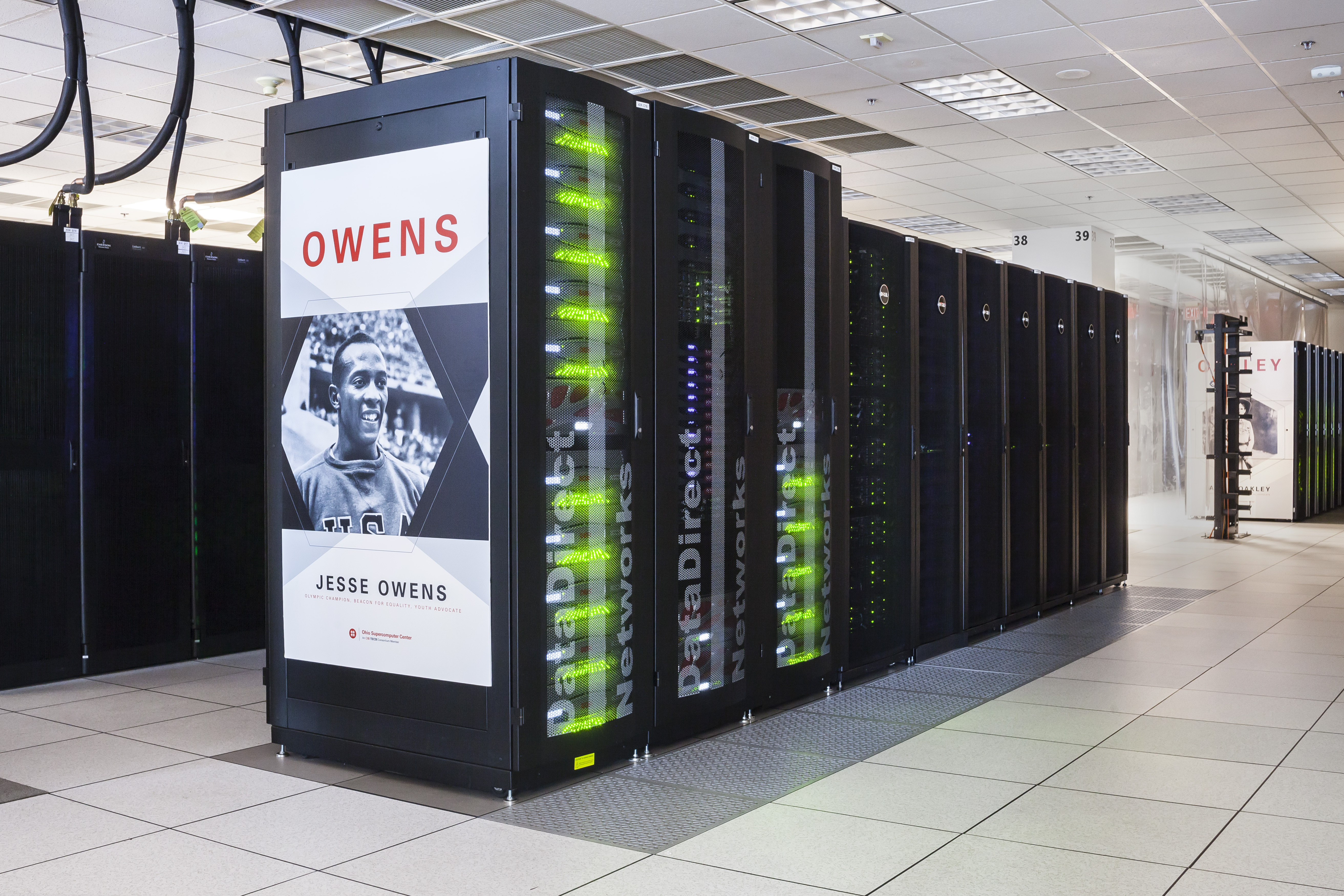J.C. “Jesse” Owens possessed both elite speed and raw power, which he honed and blended on his way to winning four Olympic gold medals in 1936.
Those impressive traits—elite speed and raw power—now are shared by the newest and most powerful supercomputer in the history of the Ohio Supercomputer Center, a system which, appropriately, is named for the late Ohio-raised sprinter.
State officials and OSC leaders gathered at a data center today (March 29) to dedicate the Owens Cluster. Chancellor John Carey, of the Ohio Department of Higher Education, explained that the state’s investment in the new system and other upgrades will increase the center’s total computing capacity by a factor of four and its storage capacity by three.

“The state of Ohio has made significant investments in the OSC since its creation to expand research in academia and industry across the state through the use of high performance computing services,” said Carey, keynote speaker for the dedication. “Deploying this new system at the center will give Ohio researchers a powerful new tool that they can leverage to make amazing discoveries and innovative breakthroughs.”
Carey joined speakers David Hudak, Ph.D., interim executive director of OSC; Thomas Beck, Ph.D., professor of chemistry at the University of Cincinnati and chair of the center’s Statewide Users Group; and Tony Parkinson, Vice President for NA Enterprise Solutions and Alliances at Dell EMC. Students, university IT leaders and researchers, policymakers and staff attended the dedication.
“This major acquisition, installation and deployment will enable our clients, both academic and industrial, to significantly enhance their computational work,” Hudak said. “Ohio researchers are eager for this massive increase in computing power and storage space. Our current systems were almost constantly running near peak capacity.”
“OSC is dedicated to keeping users involved in the evolution of its HPC systems,” Beck said. “This commitment ensures that research projects are computationally on par with work being conducted by colleagues and partner organizations throughout the state, across the country and internationally.”
“OSC’s Owens Cluster represents one of the most significant HPC systems Dell has built,” Parkinson said. “Owens features many facets of the latest technology—Intel’s Broadwell processors, Mellanox’s Enhanced Data Rate (EDR) fabric, Nvidia’s Pascal-based GPUs—and components found on the cutting edge of innovation—DDN’s Infinite Memory Engine. We at Dell are delighted to be partnering with OSC on such a significant project and are excited to see what Ohio can do with this powerful system.”
Because of his legacy as a renowned Olympic champion, a beacon for racial equality and a constant youth advocate, officials at OSC and ODHE chose to name their next supercomputer after Owens, who was raised and educated in Ohio. Owens’ name was chosen from a list of esteemed finalists that included Nobel Prize winners, famous inventors, talented musicians, well-known industrialists and a former president.
The $9.7 million investment in the Owens Cluster was part of a $12 million appropriation included in the 2014–15 Ohio biennial capital budget. The remainder of the appropriation funded new storage systems and upgrades to data center facilities to support the new and existing systems housed there.
The Owens Cluster features Dell PowerEdge servers featuring the newest Intel Xeon processors, storage components manufactured by DDN and interconnects provided by Mellanox. The new, liquid-cooled system is expected to deliver a peak performance of ~750 teraflops, tech-speak for the ability to conduct about 750 trillion calculations per second. A recently installed complement of 160 NVIDIA Tesla P100 graphics cards have boosted the total peak performance of the system to ~1.5 petaflops—a performance level of nearly 10 times that of any previous OSC system.
A nearly complete overhaul of the data center infrastructure has been completed since last spring, now providing users with nearly 5.5 petabytes of disk storage and more than five petabytes of tape backup. The center also acquired and installed NetApp software and hardware for home directory storage.
In addition to the Owens Cluster, as well as two other supercomputer clusters—the HP/Intel Ruby Cluster and the HP/Intel Oakley Cluster, provide computational support to the Ohio research community. An older system, the IBM/AMD Glenn Cluster, was retired last fall to make way for Owens.
The Ohio Supercomputer Center (OSC), a member of the Ohio Technology Consortium of the Ohio Department of Higher Education, addresses the expanding computational demands of academic and industrial research communities by providing a robust shared infrastructure and proven expertise in advanced modeling, simulation and analysis. OSC empowers researchers with the vital services essential to make extraordinary discoveries and innovations, partners with businesses and industry to leverage computational science as a competitive force in the global knowledge economy, and leads efforts to equip the workforce with the key technology skills required to secure 21st century jobs. For more, visit www.osc.edu.